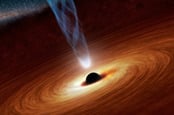This article is more than 1 year old
Did the Earth move for you, too? Grav waves sensed from black holes' bang 1.8bn LYs away
Best signal yet received after space void mega-prang
Scientists have recorded the most accurate reading of gravitational waves yet by using the upgraded LIGO and Virgo observatories together for the first time.
The ripples were detected on August 14 at the Laser Interferometer Gravitational-wave Observatories (LIGO) in Louisiana and Washington state in the US, and the Virgo detector near Pisa, Italy. Details were published in a paper in the journal Physical Review Letters this week, and announced to the world on Wednesday.
The signal was generated when two black holes about 1.8 billion light years away, with masses 31 times and 25 times the mass of our Sun, spiraled into one another and created a single, larger black hole 53 times the mass of the Sun. Energy equivalent to three solar masses was converted into gravitational waves.
France Córdova, director of the US National Science Foundation, which funds the LIGO detectors, said: "Little more than a year and a half ago, NSF announced that its Laser Interferometer Gravitational Wave Observatory had made the first-ever detection of gravitational waves, which resulted from the collision of two black holes in a galaxy a billion light-years away.

If we're in a simulation, someone hit it with a hammer, please: Milky Way spews up to 100 MEELLLION black holes
READ MORE"Today, we are delighted to announce the first discovery made in partnership between the Virgo gravitational-wave observatory and the LIGO Scientific Collaboration, the first time a gravitational wave detection was observed by these observatories, located thousands of miles apart."
The trio of observatories were upgraded with interferometers that are more sensitive, so gravitational waves with smaller amplitudes can still be detected. LIGO has evolved into a second-generation detector called Advanced LIGO, and the second observing run was from November 2016 to August 2017. The Virgo detector started running in August 2017 – two weeks before the event codenamed GW170814 was observed.
By having three detectors, researchers can work backwards and triangulate the position of the source of the gravitational waves. The region in which to locate GW170814 was narrowed down to a patch of sky measuring 60 square degrees – more than 10 times smaller than if the data was only available from the two LIGO detectors alone.
It's important to identify a smaller search region, said Laura Cadonati, deputy spokesperson for the LIGO Scientific Collaboration and a researcher at Georgia Institute of Technology.
"Many compact object mergers – for example those involving neutron stars – are expected to produce broadband electromagnetic emissions in addition to gravitational waves. This precision pointing information enabled 25 partner facilities to perform follow-up observations based on the LIGO-Virgo detection, but no counterpart [electromagnetic emission] was identified – as expected for black holes." ®
